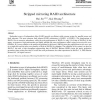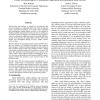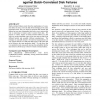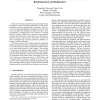JSA
2000
14 years 4 months ago
2000
Redundant arrays of independent disks (RAID) provide an ecient stable storage system for parallel access and fault tolerance. The most common fault tolerant RAID architecture is R...
FTCS
1993
14 years 5 months ago
1993
This paper describes and evaluates two algorithms for performing on-line failure recovery (data reconstruction) in redundant disk arrays. It presents an implementation of disk-ori...
OSDI
2000
ACM
14 years 5 months ago
2000
ACM
A variety of performance-enhancing techniques, such as striping, mirroring, and rotational data replication, exist in the disk array literature. Given a fixed budget of disks, one...
FAST
2003
14 years 5 months ago
2003
Current disk arrays, the basic building blocks of highperformance storage systems, are built around two memory technologies: magnetic disk drives, and non-volatile DRAM caches. Di...
ASPLOS
1992
ACM
14 years 8 months ago
1992
ACM
We describe and evaluate a strategy for declustering the parity encoding in a redundant disk array. This declustered parity organization balances cost against data reliability and...
ISCA
1994
IEEE
14 years 8 months ago
1994
IEEE
In 1989, the RAID (Redundant Arrays of Inexpensive Disks) group at U. C. Berkeley built a prototype disk array called RAID-I. The bandwidth delivered to clients by RAID-I was seve...
ASPLOS
2004
ACM
14 years 10 months ago
2004
ACM
This paper describes the design, implementation, and evaluation of a Federated Array of Bricks (FAB), a distributed disk array that provides the reliability of traditional enterpr...
STORAGESS
2006
ACM
14 years 10 months ago
2006
ACM
Batch-correlated failures result from the manifestation of a common defect in most, if not all, disk drives belonging to the same production batch. They are much less frequent tha...
ISCA
2006
IEEE
14 years 10 months ago
2006
IEEE
RAID architectures have been used for more than two decades to recover data upon disk failures. Disk failure is just one of the many causes of damaged data. Data can be damaged by...
IPPS
2007
IEEE
14 years 10 months ago
2007
IEEE
This paper investigates randomization and replication as strategies to achieve reliable performance in disk arrays targeted for video-on-demand (VoD) workloads. A disk array can p...




